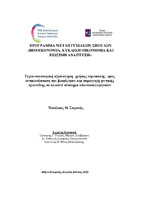Τεχνo-οικονομική αξιολόγηση χρήσης νεροφακής προς αντικατάσταση του βιοφίλτρου και παραγωγή φυτικής πρωτεΐνης σε κλειστό σύστημα υδατοκαλλιεργειών
Techno-economical assessment of using duckweed to replace biofilter and producing plant-based protein in recirculating aquaculture system

Προβολή/
Λέξεις κλειδιά
Υδατοδεξαμενή ; Απόνερα υδατοκαλλιεργειών ; Φυτοεξυγίανση ; Παραγωγή πρωτεΐνης ; Κλειστό σύστημα υδατοκαλλιεργειών (RAS) ; Επίπεδο συγκομιδής υδραυλικός χρόνος παραμονής (HRT) ; Συσσώρευση ; Βιοφίλτρο ; Απομάκρυνση αμμωνίας ; Καθαρή ταμειακή ροή ; Καθαρή παρούσα αξία ; Συντελεστής απόδοσης ; Ανάλυση ευαισθησίαςΠερίληψη
Η νεροφακή (Lemna minor, Duckweed) μπορεί να συντελέσει στην μείωση του κόστους και των αποβλήτων σε ένα κλειστό σύστημα υδατοκαλλιεργειών RAS (Recirculating Aquaculture System) με στόχο μια «βιώσιμη υδατοκαλλιέργεια». Σε αυτή τη μελέτη, σε δώδεκα υδατοδεξαμενές καλλιεργήθηκε νεροφακή με διακύμανση ως προς το επίπεδο συγκομιδής της φυτικής βιομάζας και τον υδραυλικό χρόνο παραμονής (HRΤ) του υποστρώματος. Η ανάπτυξη των καλλιεργειών πραγματοποιήθηκε σε τεχνητό υπόστρωμα κλειστού συστήματος υδατοκαλλιεργειών τιλάπιας. Με βάση τις μετρήσεις, η τελική παραγωγή βιομάζας ήταν μικρή σε σχέση με τα βιβλιογραφικά δεδομένα, ωστόσο, το πρωτεϊνικό περιεχόμενο ήταν σημαντικά υψηλότερο σε σχέση με άλλα πρωτεϊνούχα φυτά. Παράλληλα, έλαβε χώρα οικονομοτεχνική μελέτη ανάμεσα σε μονάδα κλειστού συστήματος που χρησιμοποιεί βιοφίλτρο (BFR) και σε μονάδα που αντί για βιοφίλτρο χρησιμοποιεί καλλιέργεια νεροφακής (DWD), η οποία μάλιστα χρησιμοποιείται για να καλύψει σε μεγάλο ποσοστό τις πρωτεϊνικές ανάγκες τις τιλάπιας (Oreochromis sp.).
Τελικά, το υψηλό πρωτεϊνικό περιεχόμενο της νεροφακής και η μεγαλύτερη ΚΠΑ (Καθαρή Παρούσα Αξία) και ΕΣΑ (Εσωτερικός Συντελεστής Απόδοσης), του αντίστοιχου κλειστού συστήματος RAS, ανέδειξε τη συγκεκριμένη πρακτική ως οικονομικά βιώσιμη. Παρόλα αυτά, η αυξημένη συσσώρευση θρεπτικών συστατικών που παρατηρήθηκε στο μέσο ανάπτυξης και η συνεπαγόμενη αδυναμία επαρκούς εξυγίανσης του τελευταίου, απαιτεί περαιτέρω πειραματισμό για τον καθορισμό των
6
βέλτιστων συνθηκών ανάπτυξης, όπως π.χ. η θερμοκρασία, η εκλογή του κατάλληλου HRT, η επιλογή του σωστού ποσοστού ημερήσιας συγκομιδής κ.ά.


